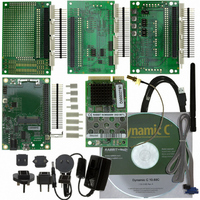101-1285 Rabbit Semiconductor, 101-1285 Datasheet - Page 47

101-1285
Manufacturer Part Number
101-1285
Description
DEV KIT DELUXE MINICORE RCM5600W
Manufacturer
Rabbit Semiconductor
Series
MiniCore™r
Type
Transceiver, 802.11 b/gr
Datasheet
1.101-1285.pdf
(130 pages)
Specifications of 101-1285
Frequency
2.4GHz
Processor To Be Evaluated
Rabbit 5000
Processor Series
RCM5600W
Interface Type
RS-232, USB, PCI
Maximum Operating Temperature
+ 55 C
Minimum Operating Temperature
- 30 C
Operating Supply Voltage
3.15 V to 3.45 V
Silicon Manufacturer
Rabbit Semiconductor
Silicon Family Name
RabbitCore
Kit Contents
Board
Features
On-board Single-Chip 802.11b/g Transceiver, Built-In Web Server
Development Tool Type
Hardware /
Rohs Compliant
Yes
For Use With/related Products
RCM5600W
Lead Free Status / RoHS Status
Not applicable / Not applicable
Other names
316-1161
- Current page: 47 of 130
- Download datasheet (2Mb)
5.1 More About Dynamic C
Dynamic C has been in use worldwide since 1989. It is specially designed for program-
ming embedded systems, and features quick compile and interactive debugging. A com-
plete reference guide to Dynamic C is contained in the Dynamic C User’s Manual.
Since the RCM5600W has a serial flash memory, all software development must be done
in the static SRAM. The flash memory and SRAM options are selected with the
Program Options > Compiler
Developing software with Dynamic C is simple. Users can write, compile, and test C and
assembly code without leaving the Dynamic C development environment. Debugging
occurs while the application runs on the target. Alternatively, users can compile a program
to an image file for later loading. Dynamic C runs on PCs under Windows NT and later—
see Rabbit’s Technical Note TN257, Running Dynamic C
additional information if you are using a Dynamic C under Windows Vista. Programs can
be downloaded at baud rates of up to 460,800 bps after the program compiles.
OEM User’s Manual
Dynamic C is an integrated development system for writing
embedded software. It runs on a Windows-based PC and is
designed for use with single-board computers and other devices
based on the Rabbit microprocessor. Chapter 5 describes the
libraries and function calls related to the RCM5600W.
NOTE: An application should be compiled directly to the SRAM on the RCM5600W
module using the Store Program in RAM compiler option while debugging for
faster upload times and to save wear on the flash, but should be recompiled to Store
Program in Flash for use after the USB cable is disconnected. Your final code must
always be stored in flash memory for reliable operation.
menu.
5. S
OFTWARE
®
With Windows Vista
R
EFERENCE
Options >
®
, for
41
Related parts for 101-1285
Image
Part Number
Description
Manufacturer
Datasheet
Request
R

Part Number:
Description:
COMPUTER SNGLBD BL2120 FRCTNLOCK
Manufacturer:
Rabbit Semiconductor
Datasheet:

Part Number:
Description:
KIT APPLCTN RABBITCORE RCM4010
Manufacturer:
Rabbit Semiconductor
Datasheet:

Part Number:
Description:
KIT MESH NETWORK ADD-ON RCM4510W
Manufacturer:
Rabbit Semiconductor
Datasheet:

Part Number:
Description:
KIT DEV FOR BL2500 COYOTE
Manufacturer:
Rabbit Semiconductor
Datasheet:

Part Number:
Description:
KIT APPLICATION SIMPLE SENSOR
Manufacturer:
Rabbit Semiconductor
Datasheet:

Part Number:
Description:
KIT DEV RCM5400W US/INTERNATIONL
Manufacturer:
Rabbit Semiconductor
Datasheet:

Part Number:
Description:
KIT FOR BL4S100 STARTER PACKAGE
Manufacturer:
Rabbit Semiconductor
Datasheet:

Part Number:
Description:
DEV KIT STANDARD MINI RCM5600W
Manufacturer:
Rabbit Semiconductor
Datasheet:

Part Number:
Description:
MODULE RABBITCORE RCM3720
Manufacturer:
Rabbit Semiconductor
Datasheet:

Part Number:
Description:
MODULE RABBITCORE RCM3220
Manufacturer:
Rabbit Semiconductor
Datasheet:

Part Number:
Description:
MODULE RABBITCORE RCM3210
Manufacturer:
Rabbit Semiconductor
Datasheet:

Part Number:
Description:
COMPUTER SGL-BOARD OP6600 W/SRAM
Manufacturer:
Rabbit Semiconductor
Datasheet:

Part Number:
Description:
COMPUTER SGL-BD BL2000 SRAM/FLSH
Manufacturer:
Rabbit Semiconductor











